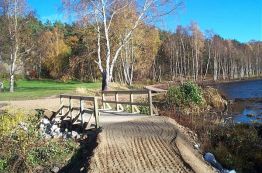Project Aim
PURE North Sea aimed to develop the various spatial functions of water catchment areas in the urban-rural fringe. The project focused especially on public participation, water quality and flood risks. Pilot projects and guidelines developed by the project, addressed various issues such as integrating water management into spatial planning, improvements with the multi-functionality of water, discovering water related identities, restored water systems and storm water management.
Project implementation and results
Spatial development
The process of PureCheck was based on Peer Review where it was the main focus for each of the transnational meetings of the PURE project. A series of nine international PureChecks was planned over the three-year term of PURE North Sea project. PureCheck was also implemented on some of the smaller initiatives taking place in the UK and elsewhere. The “PURE check”, an assessment tool for investment projects, is used intensively and has generated interest among other North Sea projects. In following projects within the Interreg IVB North Sea Region Programme, the PURE Check was used in a number of water catchment projects such as (SAWA & MARE).
Joint transnational strategy
The project’s contribution to the joint transnational strategy was the development of an assessment tool for investment projects within water catchment areas. In addition, the project also fostered concepts for local and regional water catchment areas.
Impact of the project
Policy shaping
The outcomes of the PURE North Sea project fit very well with policy guidelines on the national and European level for spatial planning and water management and in specific cases, these policies have been implemented on the local and regional scale. For instance in the Netherlands this refers to the national policy guidelines 'Nota Ruimte' and 'Watertoets (WB 21)' on spatial planning and water management. PURE North East (UK) has informed the Environment Agency's implementation of the Water Framework Directive through the publication of the Developing Effective Partnerships Research and Development with Newcastle University, and by commenting on the Environment Agency's Water for life and Livelihoods Documents. PURE North East planners attended a regional workshop at the Office of the Deputy Prime Minister developing guidance for Local Authority Planners. The North East catchment plans will be adopted as supplementary planning documents by some local authorities and this will certainly influence developments in these areas. The Water companies 5 year programme for 2005 -2010 now includes many improvements in the PURE catchments. The recommendations from the PURE Zandwetering Masterplan have been incorporated into the formal plan for the province of Overijssel in accordance with the national law 'Reconstructiewet concentratiegebieden'. The province of Overijssel made a regeneration plan following this law for regeneration areas for the Zandwetering area. |

Klare Mosse Bridge symbolizes the transformation of the Göteborg (SE) fringe to an attractive recreational area connecting the city with the Osbäcken valley and the coast
Partners City of Göteborg, SE
Municipality of Deventer, NL
Environment Agency, UK
LP:
Province of Groningen
Project Manager
Hans van Hilten
Province of Groningen Sint Jansstraat 4 / Martinikerkhof 12
Postbus 610 NL-9700 AP Groningen
The Netherlands
j.c.van.hilten@provinciegroningen.nl
www.purenorthsea.com
Tel: +31 50 316 4381
Measure: 4.1
Start Date: 26 September 2002
End Date: 01 July 2006
ERDF Grant:
 5.701.320,00 5.701.320,00
Total Eligible Sum:
 11.402.640,00 11.402.640,00
|